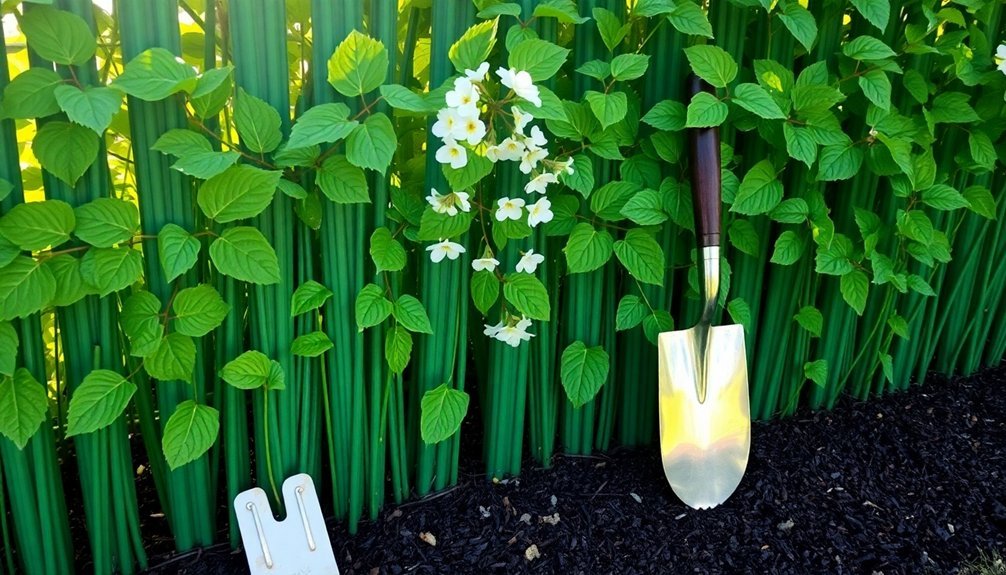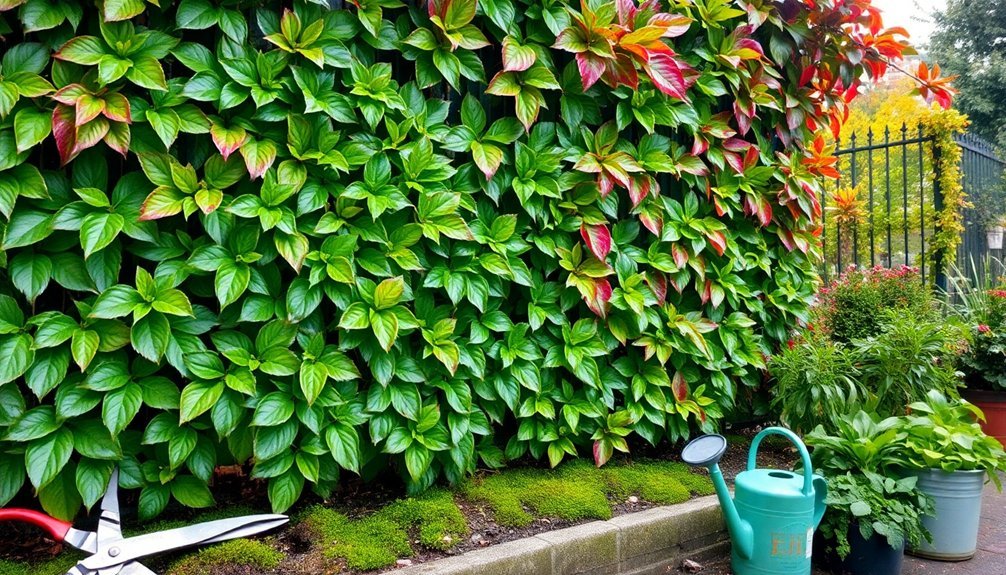Your green fence needs specific care throughout the year: spring inspection for damage and applying sealant; summer pruning and irrigation management; fall cleaning and winterizing with water-repellent treatments; and winter protection with frost cloths and mulch. You'll need to adjust maintenance based on your climate, using appropriate tools like quality pruners and eco-friendly treatments. Proper seasonal attention guarantees your living barrier thrives for years to come.
Spring Revival: Essential Care for Your Living Fence

As winter recedes and the first signs of warmth emerge, your living fence requires special attention to recover from the harsh season.
Begin with a thorough visual inspection, looking for broken branches or snow damage that might compromise your fence's structure.
A careful examination reveals winter's casualties—cracked limbs and snow-crushed sections that threaten your fence's integrity.
Check all hardware components—hinges, latches, and gates—ensuring they're secure and working properly.
Apply a protective sealant or stain after your fence has fully dried from spring cleaning to shield it from upcoming seasonal elements.
Trim back any encroaching vegetation that could obstruct or damage fence elements.
Don't overlook the importance of examining materials for rot, decay, or rust depending on your fence type. Early detection prevents costly repairs later.
Clear away accumulated debris like leaves and branches to discourage organic growth and moisture retention.
For complex issues, consider consulting a professional who can provide specialized advice on repairs or maintenance requirements specific to your living fence.
Summer Growth Management: Pruning and Irrigation Strategies
When summer heat intensifies, your green fence faces its most challenging growth period, requiring strategic management to maintain both aesthetics and structural integrity.
Inspect your fence regularly for signs of wear and implement pruning strategies to prevent overgrowth. Trim vegetation that rubs against or weighs down your fence, guaranteeing proper air circulation to prevent moisture damage. For taller plants, install support structures to reduce fence strain.
Adjust your irrigation approach by installing efficient systems with rain sensors to optimize water usage based on actual needs. The higher humidity during summer months can accelerate moss and lichen growth on fence surfaces if moisture isn't properly managed. Consider adding gravel or French drains to redirect excess water away from fence posts.
Apply UV-protective sealants to wooden components, and check fence posts to ascertain they remain solidly set as surrounding plants expand their root systems.
Fall Preparation: Winterizing Your Green Barrier

The autumn months offer a critical window for winterizing your green fence before harsh weather arrives.
You'll need to thoroughly clean your fence to remove accumulated summer dirt and debris, which prevents damaging mold and mildew growth. Use a mild detergent solution for best results. Regular maintenance during fall extends the lifespan of your fence while preventing costly repairs in the future.
- Trim overgrown vegetation around your fence to prevent moisture buildup and discourage pests that could damage your barrier.
- Conduct a thorough inspection, repairing loose boards, rusty fittings, or damaged components before winter sets in.
- Apply high-quality water-repellent sealant to protect against moisture, preventing wood rot and warping.
- Clear all leaves and yard debris from the fence perimeter and secure any loose branches that might fall during winter storms.
Winter Protection: Safeguarding Delicate Plants During Dormancy
Winter presents unique challenges for your green fence's most vulnerable components – the living plants that provide privacy and beauty.
When temperatures drop, employ frost cloths and blankets to retain heat around sensitive shrubs like Emerald Green Arborvitae and Schipka Cherry Laurel.
Don't forget to apply a thick layer of mulch for insulation, keeping roots warm throughout freezing periods.
For potted specimens, relocate them to sheltered areas or wrap pots in burlap to prevent root freezing.
Install snow fencing to minimize drift accumulation and wind damage to your privacy hedge.
Remember to deeply water plants before the first freeze, and consider creating windbreaks for additional protection.
Choose from products like Fruit Tree Covers or Fleece Jackets that are designed to provide tight wrapping for optimal cold protection.
Regularly inspect your green fence for signs of stress, especially after extreme weather events.
Climate-Specific Considerations for Living Fence Care

Your living fence's success depends on choosing drought-resistant species like juniper or boxwood for hot, dry regions.
You'll need to adjust your pruning schedule based on local climate patterns—cutting back more aggressively before growth seasons in warm areas and waiting until after the last frost in colder zones.
These climate-specific approaches will strengthen your green fence's resilience while preserving its aesthetic appeal throughout changing weather conditions.
In rainy environments, proper waterproofing is essential to prevent rot and decay that can compromise the structural integrity of your living fence barrier.
Drought-Resistant Species Selection
Selecting appropriate drought-resistant species stands as one of the most critical decisions you'll make when establishing a living fence in arid climates.
Native plants adapted to local conditions will require less maintenance and support your regional ecosystem while creating an effective barrier.
Consider these factors when choosing your drought-resistant living fence plants:
- Growth rate – Faster-growing species like Texas Privet will establish your boundary more quickly.
- Water requirements – Select plants that thrive with minimal irrigation to reduce maintenance costs.
- Soil compatibility – Match species to your specific soil type to guarantee long-term success.
- Multifunctionality – Choose plants that offer additional benefits like habitat creation, nitrogen fixation, or even edible products.
With proper selection, your living fence will remain vibrant through seasonal dry periods while requiring minimal intervention. In Southern California, varieties like Manzanita are extremely drought tolerant once established and offer historical significance as their berries were traditionally consumed by Native Americans.
Seasonal Pruning Techniques
Four distinct seasons demand different approaches to pruning your living fence, with each climate zone requiring its own specialized care calendar.
For evergreens, focus on late winter to early spring pruning, just before new growth emerges. Summer maintenance should occur after growth completes to maintain shape. For best results, avoid severe or early pruning that could stimulate unwanted new shoot growth.
Deciduous fences benefit from winter pruning when plants are dormant, promoting vigorous spring growth. Always trim overhanging branches and maintain clear space between plants and your fence structure.
Your local climate greatly impacts pruning strategies. In cold regions, prune less severely to prevent frost damage.
Hot climates call for pruning during cooler months, while high-rainfall areas require more frequent trimming to prevent disease. During drought, minimize pruning to reduce plant stress.
For ideal aesthetics, prune spring-bloomers after flowering.
Tools and Techniques for Sustainable Fence Maintenance
Maintaining green fences requires three essential components: the right tools, effective techniques, and sustainable practices. Your eco-friendly fence will last longer when you're equipped with mild detergents, rust removers, and FSC-certified materials.
Conduct bi-annual inspections to catch issues early, especially before harsh weather seasons arrive.
- Use gentle cleaning methods – Skip harsh chemicals and opt for pressure washing with eco-friendly detergents in spring and fall.
- Apply protective treatments seasonally – Use UV-blocking treatments in summer and weatherproofing before winter.
- Manage surrounding vegetation – Trim plants regularly to prevent contact damage and support fence integrity.
- Improve drainage systems – Confirm water doesn't pool around fence posts, which can cause premature rotting and structural weakness. Promptly removing accumulated snow during winter prevents structural damage to your fence from excessive weight.
Frequently Asked Questions
How Do Pesticides Affect Wildlife That Inhabit My Living Fence?
Pesticides in your living fence can harm wildlife through direct contact, secondary poisoning, and habitat disruption. They'll affect birds, beneficial insects, and small mammals that use your fence as shelter and food sources.
Can I Compost Trimmings From Treated Green Fence Plants?
No, you shouldn't compost trimmings from treated green fence plants. The chemicals in these treatments can contaminate your compost pile, potentially harming soil and plants when you later use the compost.
How Do Green Fences Affect Property Value Compared to Traditional Fences?
Green fences can boost your property value by enhancing curb appeal with natural beauty. They're particularly valuable in markets that prize sustainability, though their impact varies by region compared to traditional fencing options.
Are There Tax Incentives for Maintaining Eco-Friendly Living Barriers?
While specific tax incentives for eco-friendly living barriers are limited, you'll find some potential benefits through local rebates, property value enhancements, and environmental conservation programs. Check with your municipality for available incentives in your area.
When Is the Best Time to Establish a New Green Fence?
Spring's your best time to establish a new green fence. You'll benefit from the moderate temperatures, softer ground for planting, and spring rains that help roots establish before summer's heat arrives.
In Summary
By following these seasonal maintenance routines, you'll guarantee your green fence remains vibrant and functional year-round. Remember, your living barrier isn't just a boundary—it's an investment that improves with proper care. Don't overlook climate-specific adjustments and regular tool maintenance. With these strategies in your gardening arsenal, you're well-equipped to enjoy a thriving, beautiful green fence through every season's challenges.





Leave a Reply